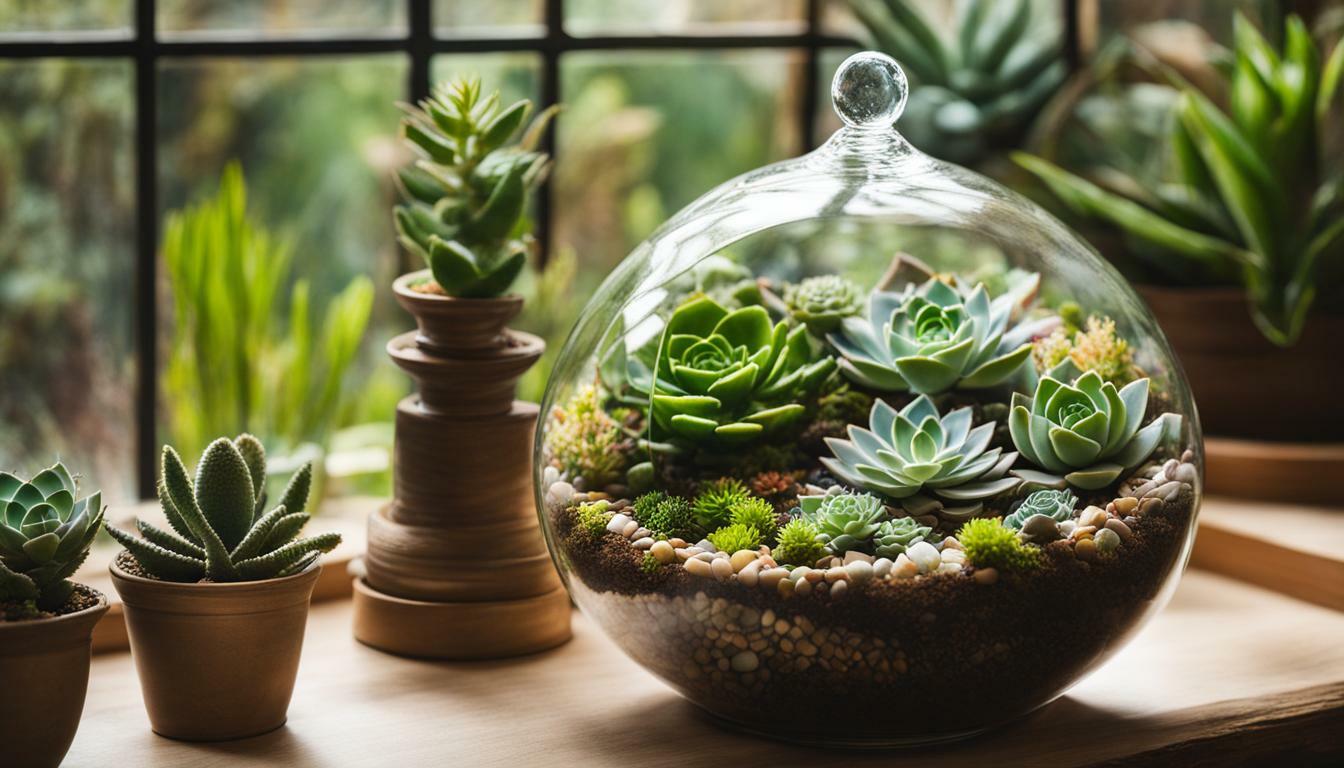Are you interested in creating a beautiful indoor garden using terrariums? Discover the best terrarium plants succulents for your indoor space with our comprehensive guide.
When selecting plants for terrariums, it’s important to consider whether you want an open or closed terrarium. Closed terrariums require tropical plants that thrive in humid conditions, such as mini ferns, tropical vines, and orchids. On the other hand, open terrariums are best suited for arid species like succulents and cacti. Some recommended succulents for open terrariums include Echeveria, Sedum morganianum ‘Burrito’, Crassula ovata ‘Minima’, Haworthia, Kalanchoe tomentosa, Curio rowleyanus, and Sempervivum. It’s important to choose a terrarium with proper airflow for succulents and to use a well-draining soil mix. Additionally, it is possible to incorporate succulents like Peperomia in closed terrariums, as they are more suited to humid conditions compared to other succulents. Overall, choosing the right succulent plants and providing proper care will help ensure the success of your terrarium gardening project.
Key Takeaways:
- Consider whether you want an open or closed terrarium when selecting plants.
- Closed terrariums are suitable for tropical plants, while open terrariums are best for arid species like succulents.
- Recommended succulents for open terrariums include Echeveria, Sedum morganianum ‘Burrito’, Crassula ovata ‘Minima’, Haworthia, Kalanchoe tomentosa, Curio rowleyanus, and Sempervivum.
- Choose a terrarium with proper airflow and use a well-draining soil mix for succulent terrariums.
- Peperomia is a suitable succulent for closed terrariums, as it can thrive in humid conditions.
Types of Terrariums: Open vs. Closed
Understanding the differences between open and closed terrariums is essential when selecting the right terrarium plants succulents for your indoor gardening project. Open terrariums are characterized by their lack of a sealed lid or cover, allowing for airflow and a drier environment. These types of terrariums are best suited for arid species like succulents and cacti, as they prefer dry conditions. In open terrariums, the moisture evaporates more quickly, preventing the plants from becoming overly saturated. On the other hand, closed terrariums feature a sealed environment, creating high humidity levels similar to a greenhouse. These terrariums are ideal for tropical plants that thrive in humid conditions, such as mini ferns, tropical vines, and orchids.
When selecting plants for closed terrariums, it’s crucial to choose ones that can tolerate high humidity and limited airflow. One option is to incorporate succulents like Peperomia, which are more suited to the humid conditions compared to other succulent varieties. However, it’s important to note that closed terrariums require careful monitoring of moisture levels and proper ventilation to prevent fungal growth. In contrast, open terrariums are perfect for succulents, which prefer drier conditions and well-draining soil. These plants typically have thick leaves that store water, allowing them to withstand periods of drought.
To create the perfect environment for your terrarium plants succulents, be sure to choose a suitable terrarium with proper airflow. This will help prevent excessive moisture buildup, which can lead to root rot and other plant diseases. Additionally, using a well-draining soil mix specifically formulated for succulents is crucial. This type of soil allows excess water to drain quickly, preventing the roots from sitting in water for extended periods. By providing the right conditions and care, you can create a thriving indoor garden filled with beautiful terrarium plants succulents.
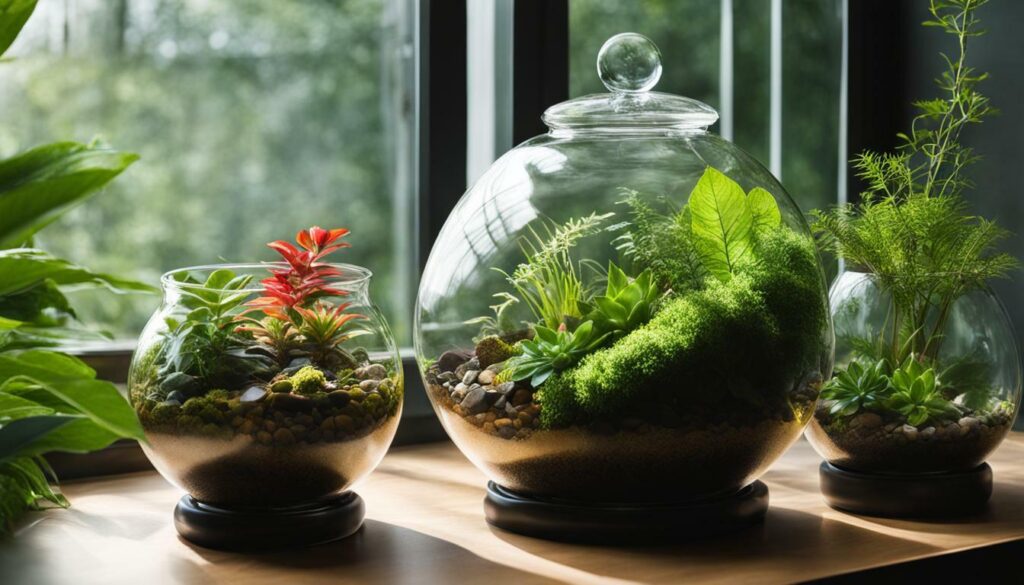
Table: Recommended Terrarium Plants Succulents for Open and Closed Terrariums
| Terrarium Type | Recommended Plants Succulents |
|---|---|
| Open Terrariums |
|
| Closed Terrariums |
|
Best Plants for Open Terrariums
If you’re planning to create an open terrarium, these low-maintenance and small succulents are perfect for adding beauty and greenery to your indoor space. Open terrariums provide a drier environment, making them ideal for arid plants like succulents and cacti. These plants have adapted to survive in harsh conditions by storing water in their leaves, stems, or roots, making them well-suited for terrariums with good airflow and a well-draining soil mix.
When selecting succulents for your open terrarium, consider varieties that stay relatively small and can thrive in the limited space of the container. Some recommended options include:
- Echeveria: Known for their beautiful rosette-shaped leaves, Echeverias come in a range of colors and textures, adding visual interest to your terrarium.
- Sedum morganianum ‘Burrito’: Also known as Burro’s Tail, this trailing succulent features long, cascading stems with fleshy, blue-green leaves. It’s a great choice for adding a touch of elegance to your terrarium.
- Crassula ovata ‘Minima’: This miniature version of the popular Jade Plant is compact and easy to care for. Its thick, shiny leaves create a unique focal point in your terrarium.
- Haworthia: With their striking geometric patterns and sturdy rosettes, Haworthias are a popular choice for terrariums. They come in various shapes and sizes, making it easy to find one that fits your terrarium’s aesthetic.
- Kalanchoe tomentosa: Commonly known as the Panda Plant, this succulent has velvety, gray-green leaves with brown spots. Its compact size and tolerance for neglect make it an excellent choice for busy plant enthusiasts.
- Curio rowleyanus: Also known as String of Pearls, this succulent has long, trailing stems with spherical leaves that resemble little pearls. It’s a visually stunning addition to any terrarium.
- Sempervivum: Known as Hen and Chicks, these charming succulents produce rosettes that multiply over time, creating a beautiful display in your terrarium. They come in a variety of colors and textures, adding interest and variety to your indoor garden.
Remember to choose a terrarium with proper ventilation and allow your succulents to dry out between waterings to prevent overwatering, which can be detrimental to their health. By selecting these low-maintenance and small succulents, you can create a vibrant and captivating terrarium that will thrive in your indoor space.
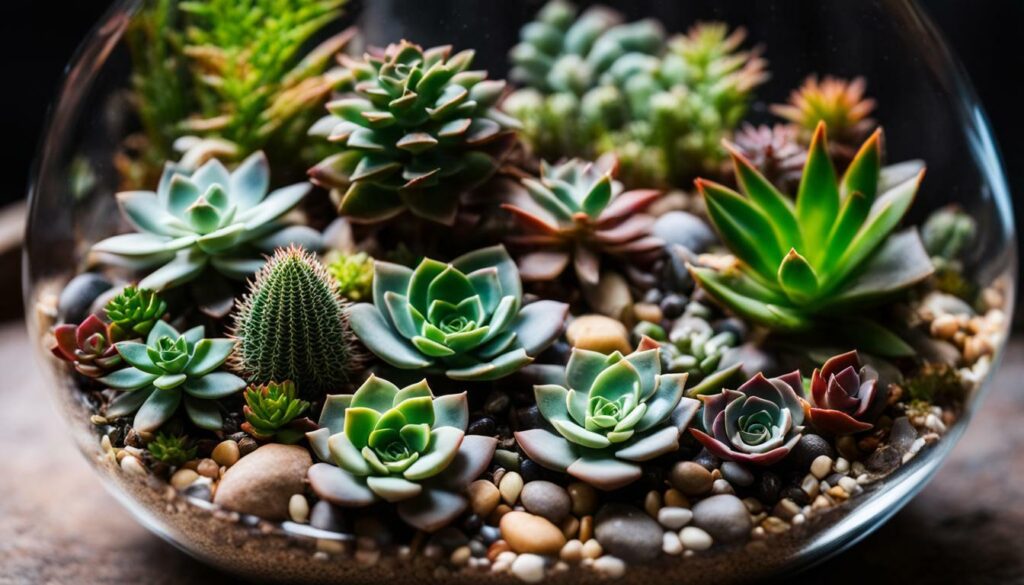
Recommended Succulents for Open Terrariums
Create a stunning open terrarium with these recommended succulents that are known for their resilience and beauty. Succulents are ideal for open terrariums as they thrive in arid environments and require less frequent watering compared to other plants. Here are some popular succulents to consider for your terrarium:
| Succulent | Scientific Name |
|---|---|
| Echeveria | Echeveria spp. |
| Sedum morganianum ‘Burrito’ | Sedum morganianum ‘Burrito’ |
| Crassula ovata ‘Minima’ | Crassula ovata ‘Minima’ |
| Haworthia | Haworthia spp. |
| Kalanchoe tomentosa | Kalanchoe tomentosa |
| Curio rowleyanus | Curio rowleyanus |
| Sempervivum | Sempervivum spp. |
These succulents come in various shapes, sizes, and colors, allowing you to create a visually appealing terrarium. Echeveria, with its rosette-shaped foliage, adds a touch of elegance, while Sedum morganianum ‘Burrito’, also known as the burro’s tail, features cascading stems that create a beautiful trailing effect.
When selecting succulents for your open terrarium, choose ones that have similar care requirements. This will make it easier for you to provide the right amount of water and light. Remember to use a well-draining soil mix to avoid waterlogged roots, as succulents are prone to root rot.
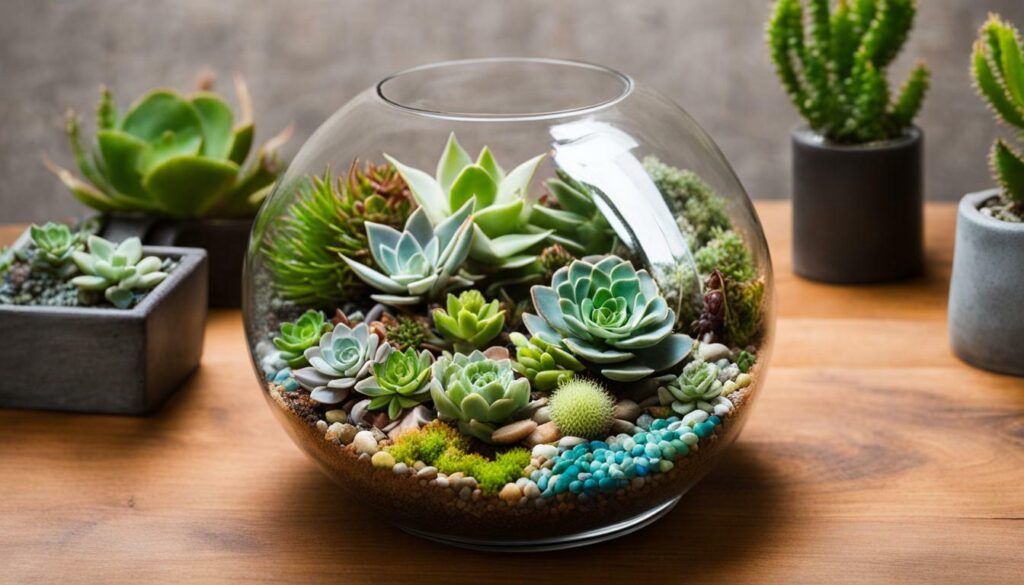
With the right selection of succulents and proper care, you can create a stunning open terrarium that will thrive and bring beauty to your indoor space. Enjoy the process of designing and caring for your terrarium, and watch as these resilient plants add a touch of greenery and tranquility to your home.
Terrarium Care Tips for Succulents
Ensuring the success of your succulent terrarium requires proper care and maintenance. Here are some expert tips to help you create a thriving indoor garden.
1. Choose the right container: Select a terrarium that provides proper airflow for your succulents. Open terrariums with vents or a partially open lid are ideal for succulents, as they require good air circulation to prevent moisture buildup.
2. Use well-draining soil: Succulents hate sitting in waterlogged soil, so it’s important to use a well-draining soil mix. Combine equal parts potting soil, perlite or pumice, and coarse sand to create the perfect soil mixture for your succulent terrarium.
3. Water sparingly: Succulents are drought-tolerant plants and prefer infrequent watering. Only water your terrarium when the soil is completely dry, typically every 10-14 days. Be careful not to overwater, as excess moisture can lead to root rot.
4. Provide ample sunlight: Succulents thrive in bright, indirect light. Place your terrarium in a spot where it can receive at least 4-6 hours of sunlight per day. If natural light is limited, you can supplement with artificial grow lights to ensure your succulents get the light they need.
Illustrative Table: Recommended Care Schedule for Succulent Terrariums
| Task | Frequency |
|---|---|
| Watering | Every 10-14 days |
| Checking soil moisture | Weekly |
| Providing sunlight | 4-6 hours daily |
| Pruning | As needed |
| Cleaning terrarium | Every 1-2 months |
Remember, each succulent variety may have specific care requirements, so it’s important to research and understand the needs of the plants you choose for your terrarium. Observing your plants and adjusting care accordingly will help you create a successful succulent terrarium that thrives in your indoor space.
By following these care tips and providing the right environment for your succulent terrarium, you can enjoy the beauty and tranquility of a thriving indoor garden. Remember to have fun and get creative with your terrarium design, and soon you’ll be reaping the rewards of your green thumb!
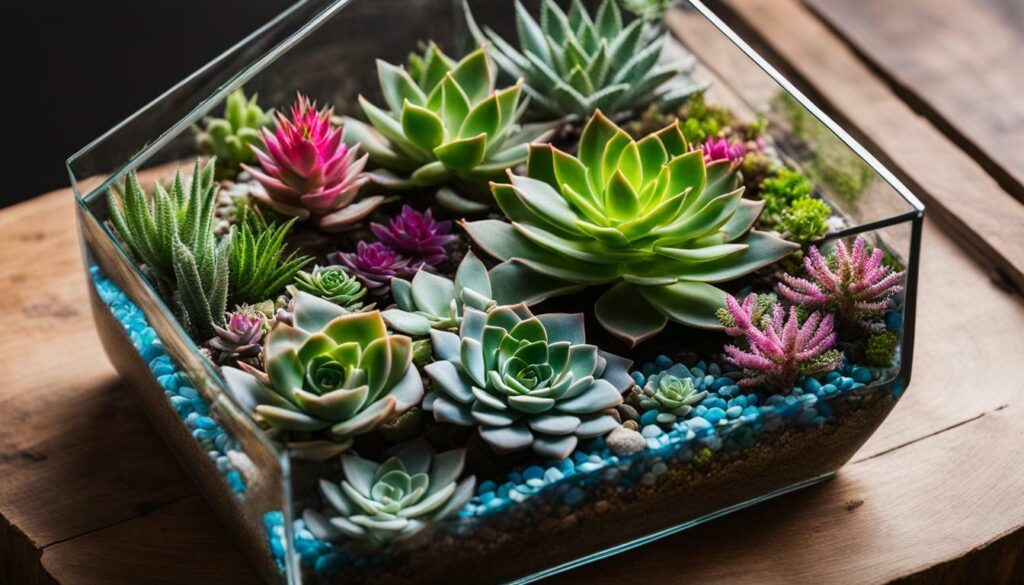
Although closed terrariums are best suited for tropical plants, some succulents like Peperomia can thrive in this environment with the right care. These succulents have adapted to withstand higher levels of humidity, making them suitable for closed terrariums where moisture is retained.
To successfully incorporate succulents in closed terrariums, it is important to create a suitable microclimate within the container. Ensure proper drainage by adding a layer of gravel or activated charcoal at the bottom, preventing water from accumulating and causing root rot.
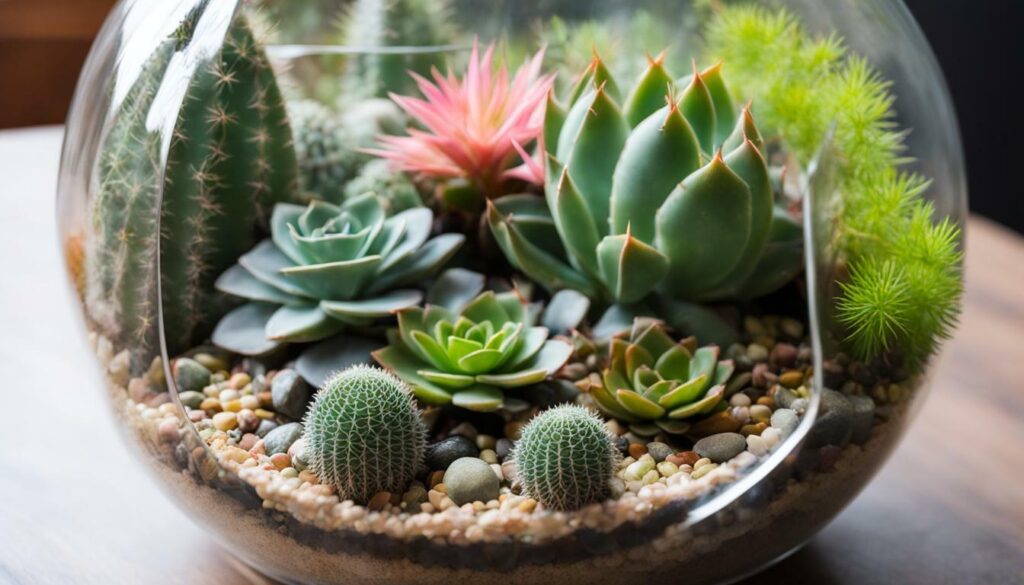
When choosing succulents for closed terrariums, Peperomia is a popular choice due to its ability to tolerate higher humidity levels. With its attractive foliage and compact growth habit, Peperomia adds a touch of greenery to closed terrariums. Other succulents like Haworthia and Gasteria can also be considered for their ability to adapt to more humid conditions.
| Succulent Variety | Light Requirements | Watering Frequency |
|---|---|---|
| Peperomia | Indirect sunlight | Allow soil to dry out between waterings |
| Haworthia | Bright, indirect sunlight | Water sparingly, allowing soil to dry out |
| Gasteria | Indirect sunlight | Water deeply but infrequently |
Remember to monitor the moisture levels within the closed terrarium and adjust watering accordingly. Too much moisture can lead to fungal growth and rot, while too little can cause the succulents to dry out.
Incorporating succulents like Peperomia in closed terrariums allows you to enjoy the benefits of these low-maintenance plants in a more humid environment. Take the time to research the specific care needs of your chosen succulents to ensure their long-term health and vitality.
Choosing the Right Terrarium and Soil Mix
Selecting the appropriate terrarium and soil mix is crucial for providing the ideal growing conditions for your succulents. When it comes to terrarium decoration ideas, the choice of container plays a significant role. Opt for a terrarium with proper airflow, such as one with ventilation holes or an open-top design, to ensure that your succulents receive enough air circulation. This is especially important for open terrariums, as succulents thrive in drier conditions.
Now, let’s talk about the soil mix. Well-draining soil is essential for succulents, as they are susceptible to root rot if they sit in stagnant water. A good soil mix for terrariums should consist of a combination of well-draining components, such as perlite, pumice, or coarse sand, to promote proper drainage. This prevents excess moisture from accumulating around the roots and helps maintain a healthier environment for your succulents.
When assembling your terrarium, layer the bottom with a thin gravel or pebble layer to further enhance drainage. Place a layer of activated charcoal on top of the gravel to absorb any excess moisture and prevent odors. Finally, add a layer of your well-draining soil mix, ensuring it covers the roots of your succulents adequately.
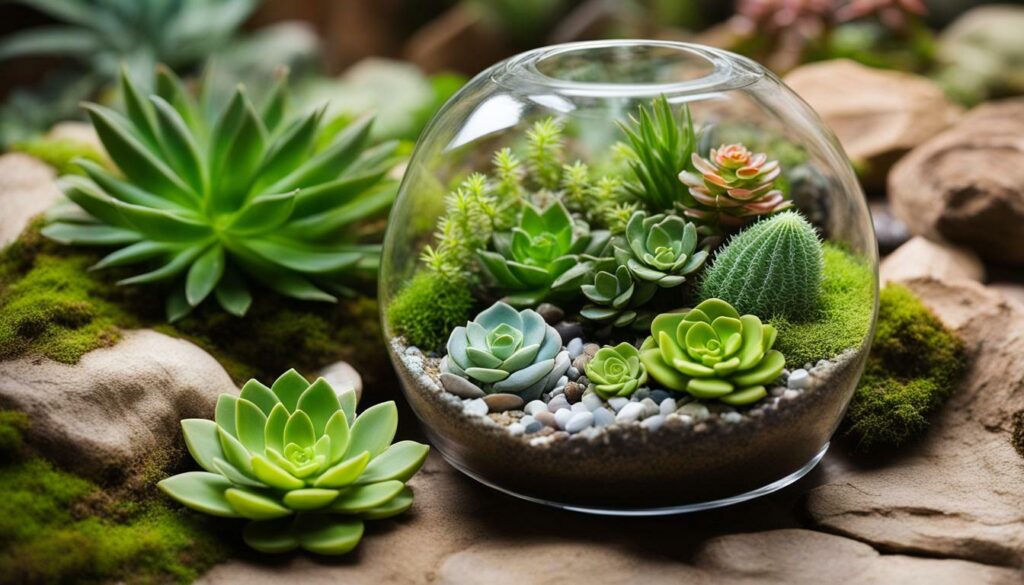
To add a touch of creativity to your terrarium, consider incorporating decorative elements like rocks, moss, or small figurines. These can provide visual interest and add a personal touch to your indoor garden. Just make sure these elements are clean and won’t introduce any contaminants that could harm your succulents.
Remember, the right selection of terrarium and soil mix can make a significant difference in the health and success of your terrarium garden. By providing proper airflow and well-draining conditions, you’ll create an environment that allows your succulents to thrive and bring beauty to your indoor space.
Succulents for Various Terrarium Sizes
No matter the size of your terrarium, these succulents are perfect for creating a stunning indoor garden. Succulents are known for their unique shapes and vibrant colors, making them a popular choice for terrariums. Whether you have a small terrarium or a larger container, there are miniature and small succulents available that will thrive in these enclosed environments.
Miniature Succulents
Miniature succulents are ideal for small terrariums as they stay compact and require minimal space. These tiny plants add a touch of charm and can create a whimsical display. Some popular miniature succulents for terrariums include:
- Echeveria: With its rosette-shaped leaves and stunning colors, Echeveria is a great addition to any terrarium.
- Haworthia: Known for its intricate patterns and textures, Haworthia is a small succulent that adds visual interest to your terrarium.
- Sempervivum: Also known as “hens and chicks,” Sempervivum forms rosettes and produces offsets, creating a unique and compact display.
Small Succulents
If you have a larger terrarium, small succulents can be used to create a lush and diverse landscape. These succulents may have slightly larger growth habits compared to miniature varieties but still maintain their compact size. Some small succulents that are perfect for terrariums include:
- Sedum morganianum ‘Burrito’: Also known as the “burro’s tail” succulent, this trailing variety adds elegance and visual interest to your terrarium.
- Crassula ovata ‘Minima’: This compact version of the popular jade plant is an excellent choice for terrariums due to its small size and resilience.
- Kalanchoe tomentosa: With its soft, velvety leaves and appealing texture, the panda plant is a favorite among succulent enthusiasts.
No matter the size of your terrarium, be it small or large, incorporating these miniature and small succulents will create a beautiful and visually appealing indoor garden. Remember to provide adequate lighting and a well-draining soil mix to ensure the health and growth of your succulents.
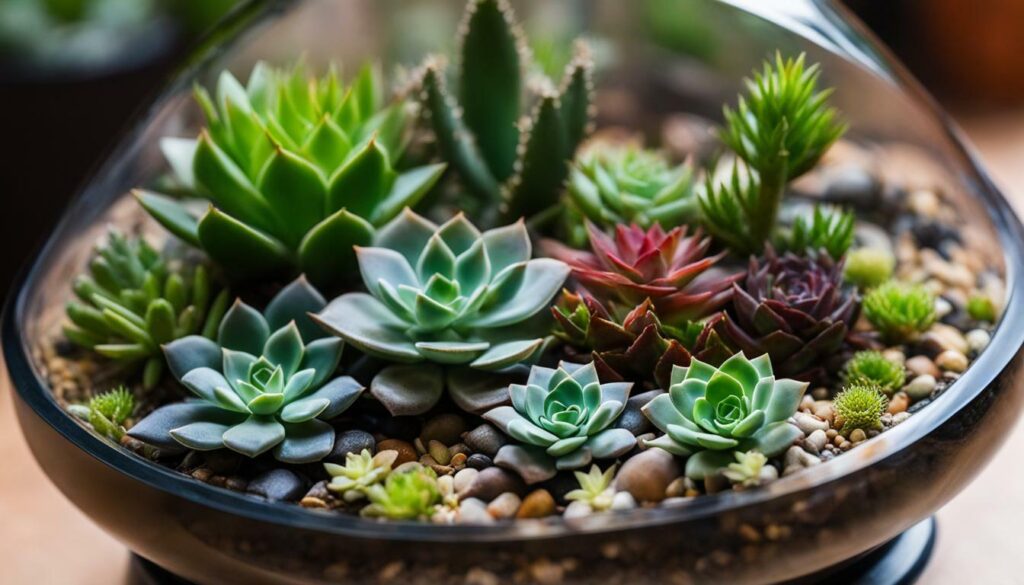
| Succulent | Description |
|---|---|
| Echeveria | A rosette-shaped succulent with a variety of colors, ranging from pastels to vibrant hues. |
| Haworthia | An intricate succulent known for its unique patterns and textures. |
| Sempervivum | Also known as “hens and chicks,” this succulent forms rosettes and produces offsets, creating a charming display. |
| Sedum morganianum ‘Burrito’ | A trailing succulent with long, cascading stems that resemble the tail of a burro. |
| Crassula ovata ‘Minima’ | A compact version of the popular jade plant, known for its small size and resilience. |
| Kalanchoe tomentosa | Also known as the panda plant, this succulent has velvety leaves and an appealing texture. |
Tips for Successful Terrarium Gardening
Unleash your indoor gardening potential with these expert tips for successful terrarium gardening. Whether you’re a beginner or a seasoned gardener, creating and maintaining a terrarium can be a rewarding and fulfilling hobby. Follow these tips to ensure your terrarium thrives with lush greenery and becomes a stunning centerpiece in your home.
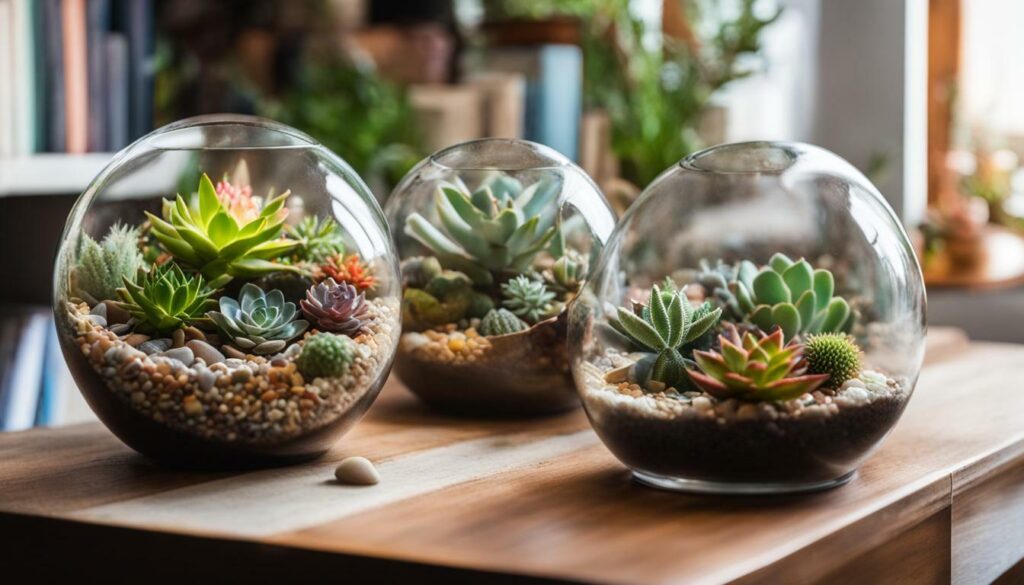
When selecting plants for your terrarium, it’s crucial to consider the type of terrarium you have. Closed terrariums require tropical plants that thrive in humid conditions, such as mini ferns, tropical vines, and orchids. These plants will enjoy the moisture trapped within the closed environment. On the other hand, open terrariums are best suited for arid species like succulents and cacti. These plants prefer drier conditions and can thrive in the well-draining soil of open terrariums.
To ensure your succulents flourish in an open terrarium, it’s essential to choose the right species. Some recommended succulents include Echeveria, Sedum morganianum ‘Burrito’, Crassula ovata ‘Minima’, Haworthia, Kalanchoe tomentosa, Curio rowleyanus, and Sempervivum. These low-maintenance succulents are ideal for beginners and will add a touch of elegance to your terrarium garden.
| Succulent | Light Requirements | Watering Needs |
|---|---|---|
| Echeveria | Direct sunlight | Water when soil is completely dry |
| Sedum morganianum ‘Burrito’ | Indirect sunlight | Allow soil to dry between waterings |
| Crassula ovata ‘Minima’ | Bright, indirect sunlight | Water sparingly |
| Haworthia | Indirect sunlight | Water when soil is dry |
| Kalanchoe tomentosa | Indirect sunlight | Water thoroughly but infrequently |
| Curio rowleyanus | Indirect sunlight | Water sparingly |
| Sempervivum | Bright, indirect sunlight | Water when soil is dry |
Adequate airflow is essential for the health of your succulents, especially in open terrariums. Choose a terrarium design that allows for proper ventilation. Additionally, use a well-draining soil mix specifically formulated for succulents. This will prevent waterlogging and promote healthy root growth.
To enhance the aesthetic appeal of your terrarium, consider incorporating decorative elements such as small figurines, pebbles, or preserved moss. These additions can add a touch of whimsy and create a visually stunning display.
Summary:
- Choose suitable plants based on the type of terrarium – closed terrariums for tropical plants and open terrariums for succulents.
- Recommended succulents for open terrariums include Echeveria, Sedum morganianum ‘Burrito’, Crassula ovata ‘Minima’, Haworthia, Kalanchoe tomentosa, Curio rowleyanus, and Sempervivum.
- Ensure proper ventilation and use a well-draining soil mix designed for succulents.
- Add decorative elements to create an aesthetically pleasing terrarium.
By following these tips, you can create a thriving terrarium garden and unlock the full potential of indoor gardening. Happy planting!
Conclusion
Start your indoor gardening journey today by incorporating the best terrarium plants succulents and create a stunning green oasis in your home. When selecting plants for terrariums, it’s important to consider whether you want an open or closed terrarium. Closed terrariums require tropical plants that thrive in humid conditions, such as mini ferns, tropical vines, and orchids. On the other hand, open terrariums are best suited for arid species like succulents and cacti.
For open terrariums, there are several recommended succulents that can thrive in these dry environments. Some popular choices include Echeveria, Sedum morganianum ‘Burrito’, Crassula ovata ‘Minima’, Haworthia, Kalanchoe tomentosa, Curio rowleyanus, and Sempervivum. These succulents are not only beautiful but also low-maintenance, making them perfect for those new to indoor gardening.
In order to ensure the success of your terrarium gardening project, it’s important to choose a terrarium with proper airflow for succulents and to use a well-draining soil mix. This will help prevent waterlogged roots and ensure that your plants thrive. Additionally, if you prefer closed terrariums, it’s still possible to incorporate succulents like Peperomia, as they are more suited to the humid conditions compared to other succulents.
By following these guidelines and providing proper care, you can create a beautiful and thriving indoor garden with terrarium plants succulents. So don’t wait any longer, start your terrarium gardening journey today and enjoy the benefits of having a stunning green oasis in your home.
Can Shade-Loving Plants also Thrive in an Indoor Terrarium?
Shadeloving terrarium plants flourish in the understory of forests, naturally adapted to low light. Similarly, within the confines of an indoor terrarium, these plants find a familiar habitat. The controlled environment, with gentle artificial or filtered sunlight, ensures their lush growth and vibrancy.
FAQ
What type of plants are suitable for closed terrariums?
Closed terrariums require tropical plants that thrive in humid conditions, such as mini ferns, tropical vines, and orchids.
What type of plants are suitable for open terrariums?
Open terrariums are best suited for arid species like succulents and cacti.
Which succulents are recommended for open terrariums?
Some recommended succulents for open terrariums include Echeveria, Sedum morganianum ‘Burrito’, Crassula ovata ‘Minima’, Haworthia, Kalanchoe tomentosa, Curio rowleyanus, and Sempervivum.
Can succulents be used in closed terrariums?
Yes, succulents like Peperomia can be incorporated in closed terrariums as they are more suited to humid conditions compared to other succulents.
What should I consider when choosing a terrarium for succulents?
It’s important to choose a terrarium with proper airflow for succulents and use a well-draining soil mix.
Are there specific succulents suitable for different terrarium sizes?
Yes, there are miniature succulents available for small terrariums and larger varieties for bigger containers.
What are some tips for successful terrarium gardening?
Some tips for successful terrarium gardening include proper watering techniques, consideration of light requirements, and being aware of potential challenges.

